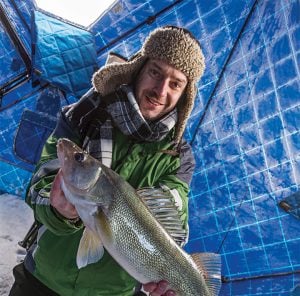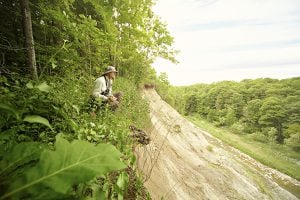(Map: Chris Brackley/Canadian Geographic)
“Wanuskewin brings people together,” says park elder Jake Sanderson, 70. “It’s not only First Nations people but people from around the world. It’s nice to see other nations come and shake hands and tell us their stories.”
No artifact illustrates the longstanding historical and cultural importance of Wanuskewin as a meeting place better than the medicine wheel. One of the site’s most interesting archeological finds, the wheel is on a ridge in the southwest corner of the park that overlooks the South Saskatchewan River and offers a 360-degree view of the surrounding plains.
The wheel consists of a seven-metre-diameter central stone cairn and a 13 metre-wide outer ring of rocks. There are also at least five smaller stone cairns, spaced between one and 17 metres away in all directions and many boulders scattered within the larger structure itself.
One of fewer than 100 known medicine wheels on the northern plains — and the northernmost of them all — it’s believed to have been created about 1,500 years ago. Unlike many medicine wheels, there are no spokes connecting the central cairn and the outer ring.
“I describe it as a gift from a creator,” says Sanderson, who was born and raised on the James Smith Cree Nation near Prince Albert and still lives in the area. “The spirit gave us this medicine wheel, to all the people, to all the animals and everything in this world and in this universe.”
Cultural experts believe medicine wheels served a range of religious and ceremonial activities, which may have included sun dances, medicine lodge ceremonies, vision quests, burials, alignment with astronomical phenomena (although there appear to be none associated with the Wanuskewin wheel) and calendrical purposes. The presence of the medicine wheel at Wanuskewin is extremely important.
“The keepers of the stories of ancient times were connected to spiritual places here on Mother Earth,” says Sanderson. “Andone of them, the main one, was the medicine wheel. The spokes were points to different sacred places on Turtle Island and the world.”
Local Indigenous Peoples use the wheel today as a site for offerings, ceremonies and songs. And the larger park continues to be a meeting place for these and other First Nations from across North America. At the end of June each year, it hosts a major celebration that kicks off the northern plains powwow season. About 50 sweat ceremonies are held here annually, as are numerous blessings, smudge ceremonies and other Native cultural art events. Saskatchewan’s Federation of Sovereign Indigenous Nations holds meetings and ceremonies at Wanuskewin, which has also hosted Indigenous groups from Nunavut, Haida Gwaii and Arizona interested in implementing similar preservation initiatives.
“This is arguably one of Canada’s top high-priority cultural projects,” says Walker. “We’re about the arts. We’re about First Nations’ interests. We’re about science. We’re about ecology and stewardship.”








